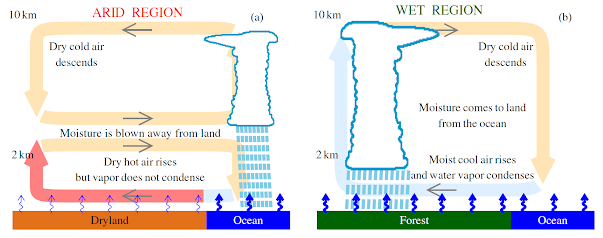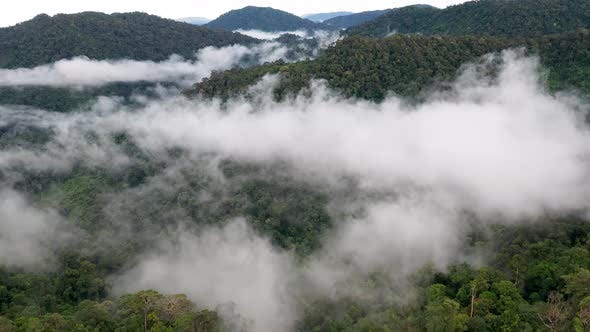The beech ("Fagus") forest of Abbadia San Salvatore, in Tuscany, Italy. A living holobiont in all its splendor. (photo by the author).
Not many people, today, have a chance to see a fully grown, mature forest. Of course, trees are common even in cities, and there are many places where trees grow together in sufficient numbers that they can be termed "woods." But mature forests have become rare in our urbanized environment.
One such mature forest survives on the slopes of the Amiata mountain (Monte Amiata), an ancient volcano located about at the center of Tuscany, Italy. Not really a "pristine" forest, but managed by humans with a sufficiently light hand so that it can grow according to its tendency of forming a "monodominant" forest. It is composed nearly completely of a single species of trees: the Fagus sylvatica the European beech. In the photo, below, you can see the east side of the Amiata mountain seen from the valley.
Our remote ancestors were, most likely, savanna creatures: they weren't used to forests. We may only imagine the awe they felt when they migrated north, from their original African home, to walk in the great forests of Eurasia, by then emerging out of the last ice age. It is a sensation that we can still feel, today. Not many of us are acquainted with the subtleties of a forest ecosystem, but we can recognize that we are looking at something gigantic: an enormous creature that dominates the land.
A forest is much more than just trees -- it is the true embodiment of the concept of "holobiont." (at least in the version called "extended holobiont" by Castell et al.). It is an assembly of different creatures that live in symbiosis with each other. The beauty of the concept is that the creatures that form a holobiont are not altruistic. Individual trees don't care about the forest -- they probably don't even know that such a thing as a "forest" exists. They all act for their own survival. But the result is the optimal functioning of the whole system: a forest is a holobiont is a forest.
It has been only in recent times that we have been able to understand part of the intricate network of relations that create the forest holobiont. You may have heard of the "mycorrhiza," the association between tree roots and fungi -- a concept known since the 19th century. It is a typical symbiotic relationship: the plant provides food (carbohydrates) to the fungus, while the fungus provides minerals for the plant. The intricate network of tree roots and fungi has been termed the "Wood Wide Web" since it connects all trees together, exchanging sugars, nitrogen, minerals, and -- probably -- information.
But trees also get together above ground to support each other. A monodominant forest, such as the beeches of Monte Amiata forms a relatively uniform canopy that provides several advantages. It shades the ground, maintaining it humid, and avoiding the growth of competing species. The trees also shield each other from the gusts of wind that may topple an isolated plant.
The canopy is the interface between the ground and the atmosphere. Trees evaporate enormous amounts of water in a process called "evapotranspiration." Trees do not do that to favor other trees -- it is their way to exploit the sun's heat to pull water and nutrients all the way from the roots to the leaves of the crown. Evaporated water is a byproduct of the process and, yet, it is fundamental for the survival of the forest.
It is a complex story that sees water being transferred from the ground to the atmosphere, where it may condense around the particles of volatile organic compounds (VOCs), also emitted by the trees. The result is the formation of low-height clouds that further shield the ground from solar heat and that will eventually give back the water in the form of rain.
But it is not just a vertical movement: the condensation of water droplets above the canopy of a forest creates a depression that generates wind. This wind may transport inland humid masses of atmosphere from the oceans, where the water had evaporated. It is the mechanism of the "biotic pump" that guarantees abundant rain whenever forests exist. Cut the forest, and you lose the rain. It is not enough to plant trees to have the rain back. You have to wait for the forest to mature and form a full canopy to trigger the biotic pump.
So, we have all the reasons to be awed at the sight of a fully grown forest. And we have all the reasons to keep it the way it is. The whole planetary ecosystem depends on healthy forests, and we have only recently learned how important forests are. Yet, we keep cutting and burning them. Is it too late to remedy the damage done? Maybe not, but we'll have to see.
To learn more
Holobionts: https://theproudholobionts.blogspot.com/2022/08/holobionts-new-paradigm-to-understand.html
About the biotic pump: https://www.bioticregulation.ru/pump/pump.php
About the role of forests on climate: https://www.nature.com/articles/s41467-021-24551-5, see also https://theproudholobionts.blogspot.com/2022/08/forests-do-they-cool-earth-or-do-they.html
For a more detailed discussion of forests as holobionts: https://theproudholobionts.blogspot.com/2022/02/the-greatest-holobiont-on-earth-old.html
Below: one of the beeches of the Monte Amiata, shown with Ugo Bardi's wife Grazia, and his Grand-Daughter, Aurora







.jpg)





